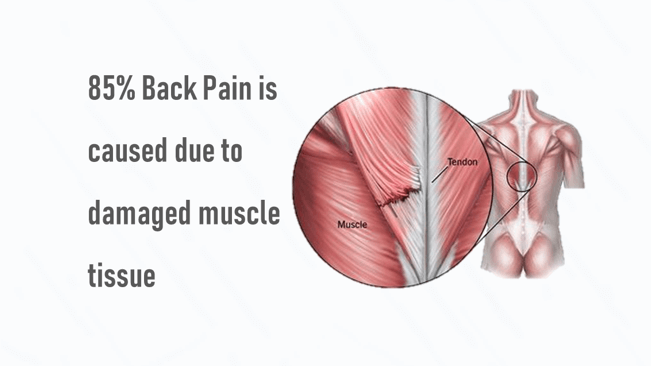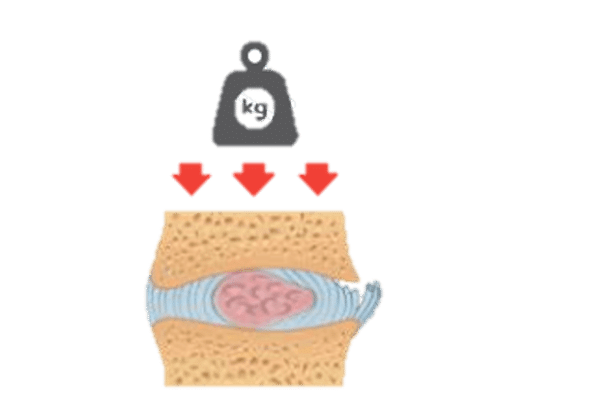Request Appointment
Enter your details and we will be in touch with you shortly;
Or call 08655885566 between 8 am and 8 pm.

Damage to soft muscle tissues in the back due to overuse

A strain can happen in any muscle or tendon and can cause pain. It may also limit movement in the affected muscle group. A muscle strain usually occurs when undue pressure is put on muscles in our daily activities.
Minor injuries can only over-stretch the muscle or its tendon whereas severe injuries can lead to a partial or complete tear of the tendon.
The common signs and symptoms depend on the severity of a muscle strain which is as follows:
 Professional diagnosis required
Professional diagnosis required Chronic, can last for years
Chronic, can last for years Treatable with 4 weeks of QI Spine Therapy
Treatable with 4 weeks of QI Spine TherapyOne of the most common sites for a muscle strain is the back. A back muscle strain usually happens due to overstretching or over-usage of muscle. Those people whose work involves repetitive movements might develop chronic muscle strain injuries. Muscle strain can be acute or chronic.
An acute strain can occur when your muscle tears suddenly which can happen while jumping, running, slipping, or lifting something heavy. An acute strain may occur as a result of: -
A chronic muscle strain is generally the result of repetitive movements or repetitive injuries when you stress a muscle by repeating the same motion again and again. It can be due to sports, poor posture, or holding back and neck in an awkward position for a long time.
 Professional diagnosis required
Professional diagnosis required Chronic, can last for years
Chronic, can last for years Treatable with 4 weeks of QI Spine Therapy
Treatable with 4 weeks of QI Spine TherapyThe commonly prescribed treatment for muscle strain is pain killers but these medicines only block out the pain without addressing the root cause of the problem which is the injury.
Over 90% of all muscle injuries are caused by strains and the back is one of the most common sites for a strain. Here are some treatments that focus on repairing damaged tissue.
X-ray and MRI tests only show damage to structures but they cannot pinpoint damaged or weakened muscles. But the DSA (digital spinal analysis) test measures spine function so that the specialists can recommend an individualized treatment plan for each patient. Advanced physiotherapy along with medical movements will heal damaged tissue and improve muscle function.
A muscle strain is caused by overusing a muscle or using it in the wrong way and while rest is essential during the initial stage, it is equally important to transition to the ‘active recovery’ stage. Spine specialists will suggest stretching and flexibility exercises based on the severity of your muscle strain so that you don’t cause additional damage to the injured muscle.
Active compression improves blood flow in the injured area, which allows more oxygen to reach damaged tissues and this results in a shorter recovery time. Compression also helps to reduce swelling which in turn, reduces pain and discomfort.
As your muscle strain heals, it is important to keep it flexible to prevent secondary problems such as a stiff back. Spine specialists will recommend exercises that you can continue to practice in order to make sure that the strained muscle heals completely so that there is no chance of a re-injury at the same location.
If the pain from a strained back muscle keeps increasing or if you start to experience bladder issues, you should consult a spine specialist right away for a definite diagnosis
Mild muscle strain could be treated at home but if your symptoms don’t improve or persist despite muscle strain treatment, or if you experience numbness or tingling; then you should consider seeing a doctor.
If the pain from a strained back muscle keeps increasing or if you start to experience severe neurological symptoms such as bladder incontinence, you should consult a spine specialist right away for a definite diagnosis.
 Professional diagnosis required
Professional diagnosis required Chronic, can last for years
Chronic, can last for years Treatable with 4 weeks of QI Spine Therapy
Treatable with 4 weeks of QI Spine TherapyThe commonly prescribed treatment for muscle strain is pain killers but these medicines only block out the pain without addressing the root cause of the problem which is the injury.
Over 90% of all muscle injuries are caused by strains and the back is one of the most common sites for a strain. Here are some treatments that focus on repairing damaged tissue.
X-ray and MRI tests only show damage to structures but they cannot pinpoint damaged or weakened muscles. But the DSA (digital spinal analysis) test measures spine function so that the specialists can recommend an individualized treatment plan for each patient. Advanced physiotherapy along with medical movements will heal damaged tissue and improve muscle function.
A muscle strain is caused by overusing a muscle or using it in the wrong way and while rest is essential during the initial stage, it is equally important to transition to the ‘active recovery’ stage. Spine specialists will suggest stretching and flexibility exercises based on the severity of your muscle strain so that you don’t cause additional damage to the injured muscle.
Active compression improves blood flow in the injured area, which allows more oxygen to reach damaged tissues and this results in a shorter recovery time. Compression also helps to reduce swelling which in turn, reduces pain and discomfort.
As your muscle strain heals, it is important to keep it flexible to prevent secondary problems such as a stiff back. Spine specialists will recommend exercises that you can continue to practice in order to make sure that the strained muscle heals completely so that there is no chance of a re-injury at the same location.
If the pain from a strained back muscle keeps increasing or if you start to experience bladder issues, you should consult a spine specialist right away for a definite diagnosis
 Professional diagnosis required
Professional diagnosis required Chronic, can last for years
Chronic, can last for years Treatable with 4 weeks of QI Spine Therapy
Treatable with 4 weeks of QI Spine TherapyFor an accurate back muscle strain diagnosis, the doctor will check your medical history and do a physical examination. It is important to establish whether the muscle has a partial or a complete tear.
The injury is graded as grade 1, 2, or 3. Grade 1 is a mild strain while grade 3 is a more severe strain.
The first step in treating muscle strain is an accurate diagnosis. The spine specialist will go through your previous medical history, your signs and symptoms – swelling, tenderness, pain intensity, etc. and a physical examination will also be conducted.
Digital Spine Analysis (DSA) test is done to find out the root cause of the problem.
It is a non-invasive functional test whose controlled and guided movement will help to analyze which muscle has gone weak and might have led to muscle strain.
 Professional diagnosis required
Professional diagnosis required Chronic, can last for years
Chronic, can last for years Treatable with 4 weeks of QI Spine Therapy
Treatable with 4 weeks of QI Spine Therapy


Have a question?
Ask our spine specialists
Who is a QI Spine Specialist?
A QI Spine Specialist is a medical expert with

Dr. Nidhi Sanghvi Shah

Dr. Manisha Moorjani

Dr. Shital Gaikwad

Dr. Richa Bhatia
9000 hours
of specialisation in treating back and neck conditions
32 hours
of spine physiotherapy specialisation methods in McKenzie concepts, Kinetic control, Neurodynamic solutions, Mulligan’s concepts
500 hours
and 6 months of QI Spine specialisation courses
A muscle strain is the tearing or stretching of muscle fibers.
According to the American Academy of Orthopaedic Surgeons, the risk factors for muscle strain are poor conditioning of muscles, muscle tightness, muscle imbalance, muscle fatigue, and old age.
Depending on the fibers damaged, muscle injury can be classified into grade I (mild), grade II (moderate), and grade III (severe).
Pain at rest, muscle weakness, swelling, bruising or redness due to an injury, and inability to use the muscle are the typical signs of a muscle strain.
The duration of recovery is based on the severity of a muscle strain. Mostly, it heals within a few weeks but if there is a severe muscle strain, it will take a longer time to recover/heal.